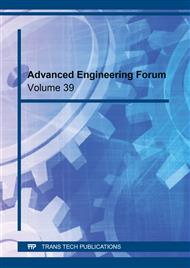p.9
p.21
p.43
p.55
p.63
p.75
p.85
p.95
p.103
Properties of Compressed Interlock Earth Blocks Manufactured from Locally Available Lateritic Soil for Low Cost Housing Projects
Abstract:
This investigation was carried out to identify the engineering properties of compressed interlock earth blocks manufactured from locally available lateritic soil and introduce to use the manufactured soil blocks to minimize the material and finishing cost for the low cost housing projects. The soil samples used in this study were well-graded lateritic sandy soil which has the composition of 1.9% gravel, 94% sand and 4.1% silt / clay. These soil samples were passed through the 100-mesh sieve and mixed with ordinary Portland cement to prepare the admixture. While compressing through a hydraulics jack by varying the compositions and the volume of soil-cement admixtures, compaction soil blocks were manufactured in a locally fabricated 250 mm x125 mm x100 mm standard steel mould. The manufactured soil blocks allowed to cure while spraying small quantity of water and covering with polythene for 28 days. Average compressive strengths of soil blocks made with 5% cement with 1.6:1 and 1.8:1 volume compactions were 1.3 Mpa and 1.9 Mpa, respectively. However, both compressive strength values were less than the standard limits of 2.8 MPa stated in SLS 1382:2009, local standards for soil blocks used for construction industry. However, soil blocks made with 10% cement under same compaction ratios attained compressive strengths of 3.0 MPa and 3.6 MPa respectively and it is above the required standards limits. However, 15% and 20% cement containing earth blocks have much higher compressive strengths but increase the cost of production. Regression analysis results confirmed the strong correlation between cement content and the compressive strength of the soil bricks. The soil bricks manufactured with more than 12.06% cement soil mix by maintaining compaction ratio into 1.6:1 or Soil bricks manufactured with more than 5.16% cement mix by maintaining compaction ratio into 1.8:1 will produce standards soil bricks for construction industry and these results further confirmed that wet and dry compressive strength of soil bricks will increase with increasing the compaction ratio and the cement content. However, when considering the compressive strength, water absorption level and cost effectiveness, soil bricks manufactured by maintaining compaction ratio into 1.8:1 with more than 5.16% cement mix will produce required standards cost effective soil bricks for construction industry.
Info:
Periodical:
Pages:
85-93
Citation:
Online since:
February 2021
Authors:
Price:
Сopyright:
© 2021 Trans Tech Publications Ltd. All Rights Reserved
Share:
Citation:


